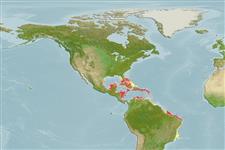Environment: milieu / climate zone / depth range / distribution range
Ekologi
laut berasosiasi dengan karang; kisaran kedalaman 5 - 20 m (Ref. 9710). Tropical
Western Central Atlantic: Florida (USA), Bahamas, Puerto Rico, Grand Cayman Island, Virgin Islands, Antigua, Barbados, Aruba, Curaçao, Colombia, and Venezuela.
Size / Weight / umur
Maturity: Lm ? range ? - ? cm
Max length : 8.5 cm TL jantan/; (Ref. 7251)
Duri punggung (Keseluruhan (total)): 18 - 21; duri punggung lunak (Keseluruhan (total)): 31-36; Duri dubur 2; Sirip dubur lunak: 33 - 37. Light brown with pale dots and a narrow mid-lateral brown stripe, sometimes broken into blotches; faint bars on body; small black spot at front of dorsal fin; mature males with more yellow on head, gill membranes black; branchiostegal rays blue (Ref. 13442).
Occurs in groups, one to a hole, in limestone or coral rubble in clear water. Feeds on small crustaceans, worms, and fishes (Ref. 5521).
Life cycle and mating behavior
Kematangan | Reproduksi, perkembang biakan | Pemijahan | telur-telur | Fecundity | Larva
Robins, C.R. and G.C. Ray, 1986. A field guide to Atlantic coast fishes of North America. Houghton Mifflin Company, Boston, U.S.A. 354 p. (Ref. 7251)
Status IUCN Red List (Ref. 130435)
ancaman kepada manusia
Harmless
penggunaan manusia
Akuarium: Komersial
informasi lanjut
Nama-nama umumSinonim (persamaan)metabolismePemangsaEkotoksikologiReproduksi, perkembang biakanKematanganPemijahanSpawning aggregationFecunditytelur-telurpekembangan telor
AcuanBudidaya airprofil budidaya airStrainGenetikaElectrophoresesDiturunkanPenyakit-penyakitPengolahanNutrientsMass conversion
mitraGambarStamps, Coins Misc.Suara-suaraCiguateraKecepatanTipe renangArea insangOtolithsOtakPenglihatan / visi
Alat, peralatan
laporan khas
muat turun XML
Sumber internet
Estimates based on models
Preferred temperature (Ref.
123201): 26.4 - 28.2, mean 27.5 °C (based on 520 cells).
Phylogenetic diversity index (Ref.
82804): PD
50 = 0.5010 [Uniqueness, from 0.5 = low to 2.0 = high].
Bayesian length-weight: a=0.00457 (0.00183 - 0.01143), b=3.08 (2.86 - 3.30), in cm total length, based on LWR estimates for this (Sub)family-body shape (Ref.
93245).
Trophic level (Ref.
69278): 3.7 ±0.55 se; based on food items.
Fishing Vulnerability (Ref.
59153): Low vulnerability (10 of 100).
Nutrients (Ref.
124155): Calcium = 141 [72, 235] mg/100g; Iron = 0.741 [0.425, 1.247] mg/100g; Protein = 18.4 [17.3, 19.5] %; Omega3 = 0.105 [0.058, 0.187] g/100g; Selenium = 21.4 [9.3, 46.7] μg/100g; VitaminA = 182 [59, 544] μg/100g; Zinc = 1.96 [1.27, 2.80] mg/100g (wet weight);
